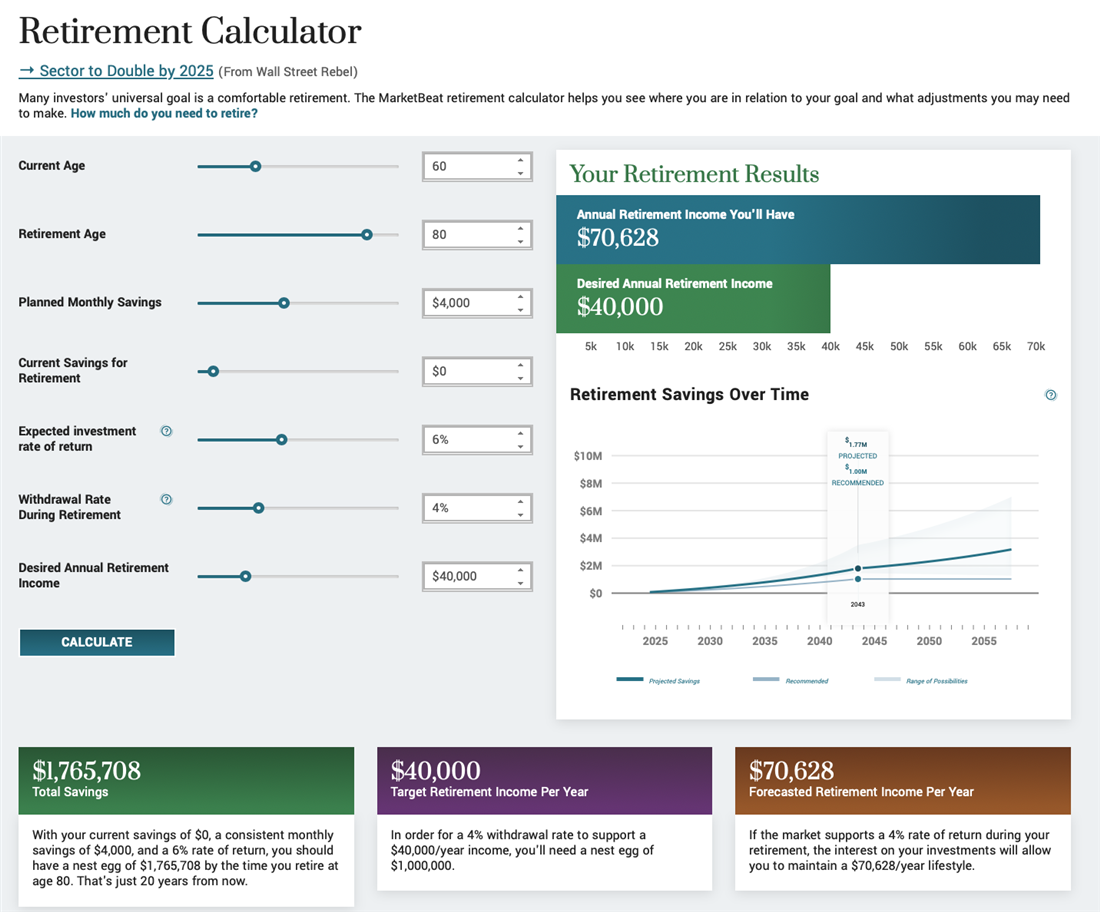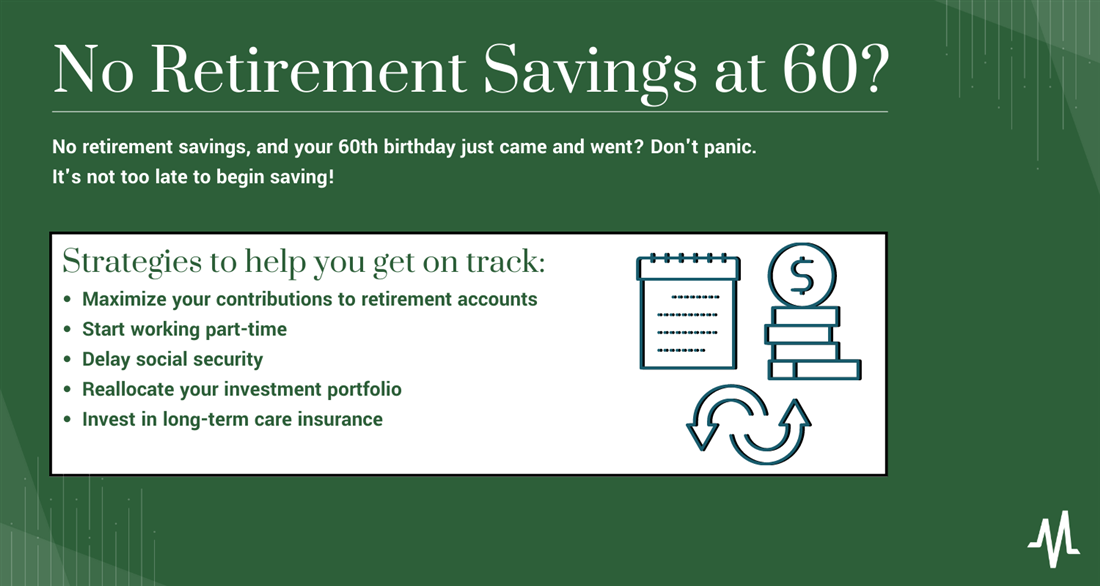To retire with the necessary funds, you must understand how to invest at age 60. This article will provide tips on where to invest your money and how much to retire at 60. It also covers how to invest in your 60s, strategies for building and managing the best retirement portfolio for 60-year-old people, and more.
With these tips for how to invest for retirement at age 60, you can decide which investments fit your situation.
How Much Should You Have Saved at Age 60?
Are you wondering, "How much do I need to retire at 60?"
Whether or not you have saved "enough" money for retirement depends on factors such as your desired lifestyle in retirement, anticipated costs, and other sources of income. Generally, retirement experts recommend having four times your annual salary saved by this age, which should provide enough money to last through the average retired person'sperson's life expectancy. However, everyone's situation is different, and there is no one-size-fits-all solution.
For those who want to become millionaires after retirement, it is still possible to do so if you save diligently before and during retirement. To determine what "enough" means, consider consulting a financial professional or using online tools such as the MarketBeat retirement calculator.

How much do you need to retire at 60? This calculator allows you to estimate how much your need to save to meet your individual goals for retirement and determine the answer.
What to Do if You Have No Retirement Savings at 60
No retirement savings, and your 60th birthday just came and went? Don't panic. It's not too late to begin saving!
Here are some strategies that can help you get on track:
- Maximize your contributions to retirement accounts: Increase your contributions to your employer-sponsored plan or a traditional or Roth IRA and take advantage of catch-up contributions if eligible.
- Start working part-time: Whether working retail, consulting in your field, or starting up a brand-new side gig, taking on additional work in your later years can help compensate for lost time in earlier years and boost your retirement income.
- Delay Social Security: Although it might be tempting to start collecting Social Security benefits as soon as possible, delaying until age 70 could increase your monthly payments by nearly a quarter.
- Reallocate your investment portfolio: Take stock of your current investments and adjust them accordingly by allocating more money toward stocks and less toward bonds and cash reserves. Although you'll take on more risk, you're also more likely to get higher returns since stocks grow faster than other investments.
- Invest in long-term care insurance: This insurance protects against the high costs of long-term care services, such as nursing home care or help with daily activities like bathing or meal preparation.
Ultimately, the best way to prepare for retirement is to start saving early and often. With these tips, you can still reach a comfortable retirement, even with a late start.

How to Start Saving for Retirement at 60
It's always possible to start saving for retirement, no matter your life stage. Even if you're 60 or older, there are still ways to set yourself up well in retirement. Here are some steps to follow to get started.
Step 1: Evaluate your current financial situation.
Before investing in your 60s, evaluate your current financial situation. Look closely at your cash flow, expenses, debts and assets to determine your net worth to help you understand where you stand financially and how much you can contribute to your retirement savings. You can use online tools from MarketBeat to help you get a clear picture of your finances.
Step 2: Choose the right retirement account.
Once you've evaluated your financial situation, the next step is to choose the right retirement account. For most people, a traditional or Roth IRA is the best option. These accounts offer tax advantages and, for a 401(k), allow you to contribute catch-up contributions of up to $7,500 per year if you're over 50. If you're still working, any employer-sponsored 401(k) plan you might have will offer matching contributions, so consider contributing to the maximum your finances allow.
Step 3: Choose the right fund.
Are you wondering, "Where should I invest my money at age 60?"
When it comes to where to invest money at age 60, the type of fund you choose is just as important as how much you save. Review analyst ratings to select a fund that best suits your needs. Various retirement funds are available, ranging from traditional mutual funds to more complex investments. Consider factors such as your risk tolerance, time horizon and need for income when deciding which fund to invest in. For example, a target date fund becomes more conservative as you get closer to retirement, allowing you to transition from growth investing to income investing gradually.
They typically hold stocks, bonds and other investments based on your desired retirement date. For example, if you plan to retire in 2030, you can invest in a target date fund, which provides the right mix of risk and return for that year.
Other retirement funds include mutual funds, where you pool your funds with other investors to buy a bucket of stocks, bonds and other investments, and index funds and exchange-traded funds (ETFs), which track certain indices such as the S&P 500 and often have lower fees.
You can also consider annuities, which typically provide payouts over an extended period (usually 10 or more years) with guaranteed returns and limited risk exposure.
Step 4: Reevaluate your plan frequently.
Retirement planning is not a one-and-done task; you should revisit it as life circumstances change. As you near retirement age, review your investments and adjust accordingly to ensure they align with your goals and needs. Additionally, consider consulting a financial planner to help ensure everything is on track for investing at 60 and beyond.
Step 5: Diversify your portfolio.
Diversification is key when investing for retirement at age 60. A diverse portfolio can help you manage risk and maximize returns. Consider diversifying your portfolio by investing in a mix of stocks, bonds and mutual funds. It is also important to consider your risk tolerance when diversifying your portfolio. While stocks can offer higher returns, they also come with higher risks.
Bonds and cash reserves, on the other hand, offer lower returns but are less risky. By diversifying your portfolio, you can balance these risks and potentially increase your chances of reaching your retirement goals.
Step 6: Consider alternative investments.
In addition to traditional retirement accounts, there are "alternative to over 60 investments" you can consider to help grow your retirement savings. Real estate and precious metals, such as physical gold or silver, are two examples of alternative investments that can provide diversification and potential growth. But do your research and understand the risks before investing in alternative options.
Step 7: Take advantage of catch-up contributions.
If you're starting late in your retirement planning, taking advantage of catch-up contributions can help you get caught up quickly. If you are starting to save for retirement at age 60, you've probably missed out on some past opportunities to contribute to retirement accounts.
However, there is still a chance to catch up. Anyone over 50 can make additional contributions to your 401(k) or IRA, allowing you to contribute up to $7,500 per year in catch-up contributions to your retirement savings accounts.
Step 8: Delay Social Security.
Delaying Social Security benefits until age 70 can significantly increase your retirement income. While you can start claiming Social Security benefits as early as age 62, you'll reduce your monthly benefit amount. However, if you delay claiming benefits until age 70, you'll get 132% of the monthly benefit amount.
Waiting can result in a substantial increase in your overall retirement income. Consider your circumstances and financial needs when deciding when to claim Social Security benefits.
A Late Start Can Still Result in a Sound Retirement
Retirement planning can be daunting, but it's always possible to start late. Following the steps outlined in this article, you can build a retirement plan tailored to your needs and goals. Developing your retirement strategy means considering your age, risk tolerance, and financial goals, not to mention diversifying your investments and taking advantage of catch-up contributions and Social Security benefits. With a comprehensive retirement plan, you can maximize your savings and help ensure you're financially secure during your golden years.
FAQs
Now that you know more, you might have additional questions about retirement savings. We tackle some of them below.
What is the best investment for a 60-year-old?
The best investment for a 60-year-old depends on your goals, risk tolerance and financial situation. Generally, investing in a combination of stocks, bonds, mutual funds, REITs (real estate income trusts) and other alternative investments can help diversify and stabilize your overall retirement portfolio. Consider whether or not you have access to catch-up contributions and Social Security benefits that you can use to maximize your retirement savings. Consulting with a financial advisor can help you make the right choices.
Is it too late to start saving for retirement at 60?
It'sIt's never too late to start saving for retirement! Starting late means that you'll need to be aggressive with your savings strategy to build up enough funds by that time.
Contributing as much as possible into tax-advantaged accounts like 401(k)s or IRAs can help maximize growth potential, and in the meantime, taking advantage of any catch-up contributions may also work in this scenario. Delaying Social Security benefits until age 70 can significantly increase your monthly income during retirement (if you can make it work).
How much should I invest to retire at 60?
As a 60-year-old, save as much as possible by contributing to tax-advantaged accounts such as 401(k)s or IRAs and taking advantage of any catch-up contributions available. Also, delaying Social Security benefits until age 70 can increase your monthly income during retirement if you are willing. Ultimately, how much you should invest for retirement depends on your circumstances, risk tolerance and financial goals. Consider consulting with a financial advisor to help create a retirement plan that best suits your needs.
Before you make your next trade, you'll want to hear this.
MarketBeat keeps track of Wall Street's top-rated and best performing research analysts and the stocks they recommend to their clients on a daily basis.
They believe these five stocks are the five best companies for investors to buy now...